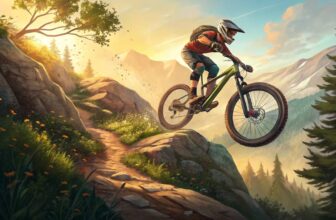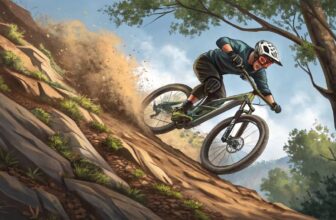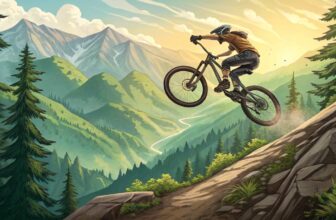Understanding Mountain Bike Frames
When you get out on the trail, the size of your mountain bike’s frame is more than just a number on a chart — it’s your ride’s backbone. Whether you’re a newbie or a seasoned pedaler, picking the right frame makes the difference between a good day out and a painful sweat-fest.
Importance of Frame Size
Getting the frame size right is kind of a big deal. Why, you ask? ‘Cause it shapes how you sit, your comfort level, and those sweet speeds you crave. Imagine your points of contact with the bike— handlebars, seat, and pedals— all playing nice together. That’s the ticket to having a comfy and less strain-y ride.
| What Matter | What You Gain with Right Fit |
|---|---|
| Comfort | Less nagging pain in back, shoulders, arms |
| Speed | Power gets where it needs to go—fast! |
| Handling | Steady as you like, with sharp control |
These days, frames are all about the “reach” — how far out from the headtube center to the bottom bracket center— that’s your new go-to for a bike that fits just right.
Effects of Incorrect Frame Size
Getting the frame size wrong is just bad news. Picture too tight or too loose jeans… yeah, not fun. A wrong size can lead to aches where you don’t want them: back, shoulders, neck, you name it. Not a great start for anyone new to the twists and turns of mountain biking.
| Wrong Size Frame | What Goes Wrong |
|---|---|
| Too Big | Messy handling, sore shoulders and neck, wonky control |
| Too Small | Energy drain, tight squeeze, quick to tire |
Sure, you can fiddle with the seat post or stem to tweak things, but that’s a band-aid, not a fix. Start with the right size to avoid clunky adjustments later on. Make adjustments icing on the cake, not the cake itself.
A frame that fits right is a no-brainer for a sweet riding experience. When your frame feels like a natural extension, you’re ready to take on any trail without second thoughts. For tips on getting the right bike size, we’ve got a deep dive waiting for you.
Key Measurements for Frame Sizing
Choosing the right mountain bike? You gotta nail the frame size for comfort and to feel like a pro on those trails. Here’s what you need to know about top tube length, reach and wheelbase, and stack height.
Top Tube Length
Consider the top tube length—it’s the distance across from the head tube to the seat tube. This crucial measurement plays a big role in the frame’s overall length and impacts how comfy and easy the bike is to handle. Whether you’re just starting, have been at it for a while, or are on a whole other level, getting this measurement right will keep you from hunching over wrong and make steering a breeze.
| Frame Size | Top Tube Length (in) | Top Tube Length (cm) |
|---|---|---|
| Small | 21.5 | 54.6 |
| Medium | 22.5 | 57.2 |
| Large | 23.5 | 59.7 |
Reach and Wheelbase
Reach is that straight path from the bottom bracket to the head tube’s center. It determines cockpit length, influencing how aggressive or chill your ride will be. Bigger frames typically offer more reach, along with a smidge longer wheelbase—perfect for those with longer torsos and who crave stability on wild rides.
Wheelbase is all about the length from the front to the back axle. The longer it is, the steadier your ride, making it a solid choice for trail lovers and daily commuters who need their bikes to last and withstand some bumps.
| Frame Size | Reach (in) | Reach (cm) | Wheelbase (in) | Wheelbase (cm) |
|---|---|---|---|---|
| Small | 15.2 | 38.6 | 43.0 | 109.2 |
| Medium | 16.2 | 41.1 | 43.5 | 110.5 |
| Large | 17.2 | 43.7 | 44.0 | 111.8 |
Stack Height
Stack height? It’s all about the vertical distance from the bottom bracket to the center of the head tube. Get this right and you’ve got your handlebars at the perfect height for comfy pedaling, especially on those extra-long rides. Nailing the stack height means you’ll be comfy and maintain performance—the dream combo, right?
| Frame Size | Stack Height (in) | Stack Height (cm) |
|---|---|---|
| Small | 22.8 | 57.9 |
| Medium | 23.8 | 60.5 |
| Large | 24.8 | 63.0 |
Did you get the itch to learn more about tweaking your bike fit? Check out our articles on mountain bike sizing and mountain biking essentials. Knowing these measurements inside out will help you find that perfect fit and seriously amp up the joy of zooming down those trails.
Adjusting Bike Fit for Comfort
Getting cozy on your mountain bike isn’t just about avoiding saddle sores; it’s also about maximizing how you ride. A key part of this bike bliss involves fiddling with the seat post and the stem, but keep it real—your bike frames gotta fit from the get-go.
Seat Post and Stem Adjustment
Tweaking the seat post and stem is your backstage pass to make your bike fit better. While these adjustments let bikes cater to different riders, they have their limits and shouldn’t replace a frame that’s already off the mark.
- Seat Post: This is where you raise or lower the saddle to sync with your leg length. Raise it too high, and you might need a different post altogether. Dialing it in right not only ramps up pedal efficiency but also keeps your knees happy and pain-free.
- Stem: It hooks your handlebars to the bike, and tweaking it affects your upper body’s reach. You’ve got two main changes here:
- Forward or Backward Slide: Swap in longer or shorter stems to either stretch or shrink your reach to the bars.
- Vertical Play: Use stems with different angles to get more upright or hunched over.
A little nip and tuck here can make your ride more comfortable, but remember—don’t compensate for an ill-fitting frame with these tweaks.
Importance of Stem and Seat Post
Why do the seat post and stem matter so much? Well, they’re your ticket to a snug fit and slick handling:
- Stem Length: Go long for speed; it ups stability, reshaping your cockpit and your whole riding position. Curious? Peep our mtb stem length guide for the full scoop.
- Seat Post Height: Pin this for smooth sailing power transfer and bye-bye knee grind. This tweak helps you ride along with less stress.
- Stem Rise: Different angles get you sitting pretty or leaning forward, dialing in how chill or charged your ride is.
Smart bike adjustments make sessions smoother, keep you from tired-out territory, and let you command the trails with confidence. For a geek-out session on all things fitting, check out our mountain bike sizing and mountain bike geometry guides.
Let’s wrap it up: Adjust that seat post and stem to polish your bike fit, but pick the right frame to start with. Don’t try fixing a square peg with round tools; use them to fine-tune a fit that’s already right. Properly set bikes mean more fun, better efficiency, and less trail trouble—because nobody wants to call it quits ’cause they’re hurting!
Mountain Bike Geometry Essentials
Picking a suitable mountain bike means grasping its geometry to ensure every ride is smooth as butter. The main bits to get cozy with are the head angle, which keeps your bike stable, and how adjustable the bike is for the perfect ride position.
Head Angle and Stability
Let’s chat about the head angle, or for the bike nerds, the technical term: the head tube angle. This fancy angle is where the head tube meets the floor, and it’s a bigwig in deciding how steady your bike feels. It’s like that friend who loves speed and needs everything just right to dash without tumbling over.
A slack head angle (think somewhere between 64 and 67 degrees) brings better stability, especially when you’re rocketing down steep hills. It’s like having extra insurance for taking those daring downhill rides at top speed. If you’re the type who lives for flying down slopes, a bike with this angle is probably your best bet.
On the flip side, a steep head angle (around the 68 to 73 degrees mark) makes your bike quick on its feet, which is top-notch for climbing and whizzing through twisting trails. This is like having a sprinter’s agility on tricky uphill paths, offering swift steering and sharp handling.
| Head Angle (Degrees) | Stability | Terrain Suitability |
|---|---|---|
| 64-67 | High | Downhill, High speeds |
| 68-73 | Low | Uphill, Tight trails |
For a deep dive into how head angles turn your ride into either a roller coaster or a ballet, check our guide on mountain biking basics.
Adjustability for Riding Position
Tweaking your mountain bike’s setup is your golden ticket to comfort and performance. The key players here are the stack height and the reach.
Stack height measures the vertical gap from the bottom bracket to the head tube’s center. It’s crucial for setting up where your bum and hands hang out when you pedal. Higher stack height? You get a laid-back, comfy vibe. Lower it, and you’re in for an aggressive, racing stance.
| Stack Height | Riding Position | Best For |
|---|---|---|
| High | Upright, Comfortable | Long journeys, Newbies |
| Low | Aggressive, Speedy | Racing, Pros |
Reach is the go-go gadget arm stretch from the bottom bracket to the head tube, affecting how sprawled you feel on the bike. For blazing speed and rock-steady rides, long reach is the hero. Want more twisty-and-turny action? Aim for a shorter reach for that snug, nimble ride.
| Reach | Stability | Nimbleness |
|---|---|---|
| Long | High | Low |
| Short | Low | High |
Adjusting the seat and stem can dial in comfort to match your style (Evo). Curious about making your bike fit like a glove? Take a gander at our guide on the mountain bike stem length guide.
By getting to know these mountain bike geometry essentials, you’re on the fast track to picking the right frame and gearing up your ride for peak comfort and performance. For a simple guide on picking the right size, see our mountain bike sizing section.
Choosing the Right Frame Size
Getting the perfect frame size for your bike is like finding your ideal pair of shoes—essential for a comfy ride where you can show off your skills. We’ll break down important bits about reach and frame shapes for different types of bikes.
Reach Over Seat Tube Length
For riders, it’s all about reaching these days rather than just eyeing that seat tube. Think of it like this: reach is the horizontal distance from where the front fork meets the frame to where the pedals crank around. It’s a real game-changer, letting you find a sweet spot between chilling out and zipping around. Gone are the days when folks relied on just a seat tube to pick their ride.
| Frame Size | Small | Medium | Large |
|---|---|---|---|
| Reach (mm) | 420 | 450 | 480 |
As bikes get bigger, you’re gonna notice that extra reach pretty quickly. The cockpit stretches out as the bike grows, matched with a little extra wheelbase which makes the whole setup longer. Great for anyone with a taller torso or someone who’s into living life on the wild side.
For the comfiest and best performance, get that reach aligned with your unique shape and flexibility instead of using old-school methods.
Varying Geometries for Bike Types
Choosing a mountain bike is like picking a superhero with the best power suited to your style. Geometries differ depending on whether you’re shredding trails, tackling enduros, or cruising cross-country.
A head angle, or how sloped the front fork is, makes a huge impact. A relaxed angle feels like a stable beast when you’re flying downhill. Sharp angles, though, make quick work of uphill and twisty spots.
| Bike Type | Trail | Enduro | Cross-Country |
|---|---|---|---|
| Head Angle | 65° – 67° | 63° – 66° | 68° – 70° |
| Reach (Medium Frame) | 450 mm | 460 mm | 440 mm |
For mountain bikes, wheel size isn’t your go-to for measuring size (unless you’re buying a kid’s bike). Match your inseam with the seat tube length to get the right fit (BikeFair).
Think about what kind of ride you want: more steady going down crazy fast (relaxed head angle) or quick moving for climbs (steep angle). For more tuning tips, check out links to nail your setups, like MTB suspension setup and mountain bike pedal types.
By honing in on reach and getting to grips with different bike frames, you’ll have a ride that fits you like a glove and makes every outing feel just right.
Getting the Right Fit for Your Bike
Picking the right mountain bike size isn’t just about looking cool; it’s about comfort and better performance on the trails. Finding the perfect fit means pinning down two crucial measurements: how tall you are and your leg inseam. Use these numbers to nail the right frame size and get the most out of your biking adventures.
Figuring Out Your Leg Inseam
Your leg inseam is key to picking the right bike frame. Here’s how to get this important number:
- Stand straight with your back to a wall and feet about six inches apart.
- Slip a book between your legs, snug against your pelvic bone as if it were a bike seat.
- Measure from the floor to the top of the book.
This’ll help you figure out your bike’s stand-over height, so there won’t be any uncomfortable interactions with the top tube when you stop.
Picking the Right Size for Your Height
Pairing your height with the correct frame size is essential for a good fit. Here’s a handy guide:
| Height (ft/in) | Height (cm) | Frame Size (in) | Frame Size (cm) |
|---|---|---|---|
| 4’10” – 5’2″ | 148 – 158 | 13 – 14 | 33 – 36 |
| 5’2″ – 5’6″ | 158 – 168 | 15 – 16 | 38 – 41 |
| 5’6″ – 5’10” | 168 – 178 | 17 – 18 | 43 – 46 |
| 5’10” – 6’1″ | 178 – 185 | 19 – 20 | 48 – 51 |
| 6’1″ – 6’4″ | 185 – 193 | 21 – 22 | 53 – 56 |
| 6’4″ & above | 193 & above | 23 – 24 | 58 – 61 |
For a deeper dive into sizes, check out our article on mountain bike sizing.
Getting a great bike fit is not just about these simple measurements. You gotta think about stuff like the top tube length, reach, and stack height. Fine-tune your ride by adjusting the stem length or tweaking the seat post. For tips on making your ride more comfy, go through our articles on mtb suspension setup and customizing bike components.
Upgrading for Performance
So you wanna pimp that mountain bike for the ultimate joyride? Let’s talk about two things that’ll seriously boost your experience – cruising speed and masterful control. Whether you’re just looking to upgrade from a rusty old bike or you’re that pro always chasing the next buzz, these tweaks are your ticket.
Boosting Bike Efficiency
Think of efficiency like this: it’s the secret sauce to keep you zooming with less sweat. A few smart upgrades can transform your trusty bike into a lean, mean riding machine.
Components and Upgrades
- Drivetrain: Ever felt like your feet were stuck in the mud with every push? Swap to a slicker drivetrain setup. Check out something like a 1x MTB conversion – it’s like swapping out a clunky typewriter for a sleek laptop, reducing weight, and easing up that gear shifting drama.
- Tires: Tires are like shoes; they gotta fit the terrain. You want something that rolls easily to save energy for those long trails. Look for a tread that suits where you ride the most.
- Wheels: Light and firm wheels give you speed without the wobble. Opt for big ones like 29-inch if you’re tall, they glide over bumps like a dream. Wanna know more about wheel sizes? Check 27.5 vs 29er MTB.
Shedding Some Pounds
| Component | Weight Off (lbs) |
|---|---|
| Drivetrain | 1 – 2 |
| Tires | 0.5 – 1 |
| Wheels | 1 – 3 |
Mastering Bike Control
Now, control is king when you’re barreling down steep slopes or zigzagging through tight spots. Let’s pimp that control with some killer component swaps.
Components and Upgrades
- Suspension: Dial in your suspension setup to match your ride style and weight. It’s like getting custom-fit shoes that make you feel like you’re floating.
- Brakes: Fancy stopping before that tree jumps into your path? Upgrade to hydraulic disc brakes—they stop on a dime and let you finesse your speed. Check our mountain bike brakes comparison to pick the best.
- Handlebars and Stem: Go wide with handlebars for a Jedi-like command over your balance. Tweak the stem for a comfy stance. Peek at our MTB stem length guide to find your sweet spot.
Getting a Grip
| Component | Control Boost Rate |
|---|---|
| Suspension | 20 – 30% |
| Hydraulic Brakes | 30 – 50% |
| Wider Handlebars | 10 – 15% |
Choose your bike mods wisely to make your ride not just faster but a whole lot smoother and safer. For more juicy tidbits, dive into our mountain bike maintenance and how to clean mountain bike sections. Plus, check that you’re riding with just the right MTB tire pressure to keep you flying on two wheels.
Personalizing Your Bike Setup
Getting the right setup for your mountain bike is like finding the perfect pair of shoes—it just makes everything better. Let’s dig into how you can tweak those bike bits to ramp up comfort and nail that trail performance.
Customizing Components for Comfort
Every rider knows, where you sit and what you touch matters! Picking the right bits and pieces can turn any rough ride into a sweet journey.
- Grips: Got achy hands? Cushy grips that kill vibrations are your new best pal. Check out those grips that give hand pain a miss on our grip guide.
- Saddle: The right saddle is like a sofa for your bottom. Make sure you have the padding you need and that it’s sitting pretty at the right height.
- Pedals: Whether you love the freedom of flats or the control of clipless, there’s a pedal for you. See which type wins your vote on pedal choices.
- Tires: Sticky tires and the right pressure can make a world of difference. Get smarter about tire choice and pressure with our resources on tire compounds and pressure tips.
- Handlebars and Stems: Get your bar and stem just right for the ideal fit. Learn how to tweak till it’s just right over at handlebar width and stem length guide.
| Component | What it does for you |
|---|---|
| Grips | Keeps your hands comfy |
| Saddle | Makes long rides feel shorter |
| Pedals | Changes up control and feel |
| Tires | Grips better and rolls nicer |
| Handlebars and Stem | Gets your sitting spot on |
Tailoring Suspension Settings
Dialing in your suspension is like giving your bike a cushion of air—smooths everything out just right. Let’s fine-tune those bouncy bits!
- Fork Settings: The fork’s air pressure and rebound need to match your weight and how you ride. Dive into the nitty-gritty with our fork maintenance guide.
- Rear Shock: Set up your shock to help the back end dance over bumps like a pro. Get the scoop on that with our rear shock guide.
- Suspension Tuning: Tweak your shock settings until everything feels smooth and in control. Our suspension setup page shows you the way.
Taking the time to adjust these can really put the “yay” in your day. For more tips on how to trick out your ride, swing by our upgrade priority guide. Don’t forget, we’ve also got the deets on bike pedal types and how to give your bike a good clean. Happy trails!




